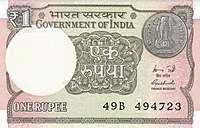Indian 1-rupee note
| (India) | |
|---|---|
| Value | ₹1 |
| Width | 97 mm |
| Height | 63 mm mm |
| Weight | 90 GSM g |
| Security features | Watermark |
| Material used | 100% (Cotton) Rag Content |
| Years of printing | 1917–1926 1940–1995 2015– |
| Obverse | |
 | |
| Design | One-rupee coin |
| Reverse | |
 | |
| Design | Sagar Samrat oil rig |
The Indian 1-rupee note (₹1) is made up of hundred 100 paise as ₹1 = 100 paise. Currently, it is the smallest Indian banknote in circulation and the only one being issued by the Government of India, as all other banknotes in circulation are issued by the Reserve Bank of India. As a result, the one rupee note is the only note bearing the signature of the Finance Secretary and not the Governor of the RBI.[1] Predominantly pinkish green paper is used during printing.
The 1-rupee note was first introduced on 30 November 1917, but printing was discontinued in 1926.[2] Printing then restarted in 1940 and continued until 1994, when it was stopped again due to cost-cutting measures. Printing resumed for a second time in 2015. The newly-printed notes were first released on 5 March 2015 at Srinathji Temple, Rajasthan by Rajiv Mehrishi, Finance Secretary. Once again RBI decided to issue these notes as per publication in The Gazette of India on 7 February 2020.[3]
Languages
As like the other Indian rupee banknotes, the ₹1 banknote has its amount written in 17 languages. On the obverse, the denomination is written in English and Hindi. On the reverse is a language panel which displays the denomination of the note in 15 of the 22 official languages of India. The languages are displayed in alphabetical order. Languages included on the panel are Assamese, Bengali, Gujarati, Kannada, Kashmiri, Konkani, Malayalam, Marathi, Nepali, Odia, Punjabi, Sanskrit, Tamil, Telugu and Urdu.
| Denominations in central level official languages (At below either ends) | |||||||||||
|---|---|---|---|---|---|---|---|---|---|---|---|
| Language | ₹1 | ||||||||||
| English | One rupee | ||||||||||
| Hindi | एक रुपया | ||||||||||
| Denominations in 15 state level/other official languages (As seen on the language panel) | |||||||||||
| Assamese | এক টকা | ||||||||||
| Bengali | এক টাকা | ||||||||||
| Gujarati | એક રૂપિયો | ||||||||||
| Kannada | ಒಂದು ರುಪಾಯಿ | ||||||||||
| Kashmiri | اَکھ رۄپَے | ||||||||||
| Konkani | एक रुपया | ||||||||||
| Malayalam | ഒരു രൂപ | ||||||||||
| Marathi | एक रुपया | ||||||||||
| Nepali | एक रुपियाँ | ||||||||||
| Odia | ଏକ ଟଙ୍କା | ||||||||||
| Punjabi | ਇਕ ਰੁਪਈਆ | ||||||||||
| Sanskrit | एकरूप्यकम् | ||||||||||
| Tamil | ஒரு ரூபாய் | ||||||||||
| Telugu | ఒక రూపాయి | ||||||||||
| Urdu | ایک روپیہ | ||||||||||
Gallery
-
Indian one rupee note
-
Indian one rupee note
References
Lua error in mw.title.lua at line 346: bad argument #2 to 'title.new' (unrecognized namespace name 'Portal').
- ^ "Issue of Re. 1 denomination currency notes with Rupee symbol (₹) and the inset letter 'L'". RBI. Retrieved 6 January 2018.
- ^ "History of Indian currency: How the rupee changed". The Economic Times. 28 November 2016. Retrieved 22 May 2023.
- ^ "Issue of ₹ 1 denomination currency notes with Rupee symbol (₹) and the inset letter 'L'". Reserve Bank of India.
- Short description with empty Wikidata description
- All Wikipedia articles written in Indian English
- Articles containing Hindi-language text
- Articles containing Assamese-language text
- Articles containing Bengali-language text
- Articles containing Gujarati-language text
- Articles containing Kannada-language text
- Articles containing Kashmiri-language text
- Articles containing Konkani (macrolanguage)-language text
- Articles containing Malayalam-language text
- Articles containing Marathi-language text
- Articles containing Nepali (macrolanguage)-language text
- Articles containing Odia-language text
- Articles containing Punjabi-language text
- Articles containing Sanskrit-language text
- Articles containing Tamil-language text
- Articles containing Telugu-language text
- Articles containing Urdu-language text
- Rupee
- Banknotes of India
- One-base-unit banknotes
- Banknote stubs

